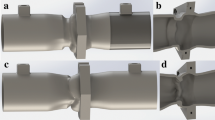Abstract
Cineradiography has revealed the presence of the “non-fully-open” phenomenon in patients with the ATS valve. Preliminary in vitro investigations have identified two contributing factors: the expanding space at the outlet of the valve, and the local flow in the pivot area. This further study was performed with the aim of elucidating these factors with respect to different sizes of the ATS valve. Three bileafet valves, ATS, CarboMedics (CM), and St. Jude Medical (SJM), with tissue annulus diameters of 25 and 29 mm, were studied. The hydrodynamic performance of the valves was tested at the mitral position of our own pulse duplicator. The opening angle was measured using a high-speed video camera. All the CM and SJM valves were able to open fully in these tests, whereas the 25-mm and 29-mm ATS valves opened to 75° and 82°, respectively, despite their design maximum of 85°. The ATS exhibited the smallest pressure drop of the 29-mm valves, and the SJM the smallest of the 25-mm valves. The incomplete opening of the ATS valve might be explained by the ability of its leaflets to align themselves with the divergent outlet flow, due to its unique open-pivot design. Such a feature would also exhibit a low pressure drop, as seen in the 29-mm valve. The smaller opening angle in the 25-mm valve, however, could be caused by the additional pivot-flow, which might cause greater deviation of the leaflets in the smaller valve, resulting in a higher relative pressure drop.
Similar content being viewed by others
References
Ely JL, Emken MR, Accuntius JA, Wilde DS, Haubold AD, More RB, Bokros JC. Pure pyrolytic carbon: preparation and properties of a new material, ON-X carbon for mechanical heart valve prostheses. J Heart Valve Dis 1998;7:626–632
Walker DK, Brendzel AM, Scotten LN. The new St. Jude Medical regent mechanical heart valve: laboratory measurements of hydrodynamic performance. J Heart Valve Dis 1999;8:687–696
Gao ZB, Hosein N, Dai FF, Hwang NH. Pressure and flow fields in the hinge region of bileaflet mechanical heart valves. J Heart Valve Dis 1999;8:197–205
Gross JM, Shu MC, Dai FF, Ellis J, Yoganathan AP. A microstructural flow analysis within a bileaflet mechanical heart valve hinge. J Heart Valve Dis 1996;5:581–590
Shiono M, Sezai A, Omoto R, Kyo S, Hatanaka M, Kitamura S, Kawachi K, Hasegawa J, Kawazoc K, Sasaki T. Multi-institutional experience of the ATS open pivot bileaflet valve in Japan. Ann Thorac Cardiovasc Surg 1996;2:51–58
Aoyagi S, Kawara T, Fukunaga S, Mizoguchi T, Nishi Y, Kawano H, Arinaga K. Cineradiographic evaluation of ATS open pivot bileaflet valves. J Heart Valve Dis 1997;6:258–263
Feng ZG, Umezu M, Fujimoto T, Tsukahara T, Nurishi M, Kawaguchi D, Masuda S. Analysis of ATS leaflet behavior by in vitro experiment. J Artif Organs 1999;2:46–52
Feng Z, Umezu M, Fujimoto T, Tsukahara T, Nurishi M, Kawaguchi D. In vitro hydrodynamic characteristics among three bileaflet valves in the mitral position. Artif Organs 2000;24:346–354
Author information
Authors and Affiliations
Corresponding author
Rights and permissions
About this article
Cite this article
Feng, Z., Nakamura, T., Fujimoto, T. et al. Influence of valve size on the hydrodynamic performance of the ATS valve. J Artif Organs 4, 303–307 (2001). https://doi.org/10.1007/BF02480022
Received:
Accepted:
Issue Date:
DOI: https://doi.org/10.1007/BF02480022




